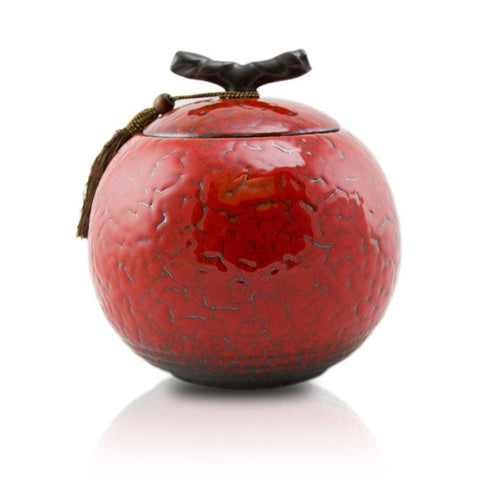by Maggie Thompson

OneWorld Memorials' Cherry Ceramic Medium-sized Cremation Urn
Ceramic aesthetics of design and motif from the Song Dynasty have stood the test of time. They are classic, yet highly regarded today for their pleasing appearance and effect. The Oriental cremation urns made with these techniques make for stunning urn vessels.
During the Song Dynasty in China (960-1279), the ceramics industry flourished. The imperial court sponsored five famous kilns (Ru, Guan, Ge, Jun, and Ding), which led to a variety of classic wares that are usually associated with a specific region of China. The imperial court-imposed forms, production techniques, and raw materials resulted in the rapid spread of kilns throughout the country. In addition to the court-patronized kilns, there were also pedestrian kilns (Cizhou, Yaozhou, and Jianyang) that provided functional ware for daily life. Some kilns could produce as many as 20,000 objects a day. Shards of Song porcelain have been found all over Asia.
Song kilns produced many designs of cups, bowls, plates, boxes, ink slabs, pillows (headrests), vases and porcelain urns. Pieces from the Ding region were the first ware to be universally recognized as premier porcelain. Regional ceramic wares were so valued during their day, that they could be used as tribute and yearly taxes to the imperial court.
What makes Song ceramics unique?
Song Dynasty ceramics maintain a unique position in the history of ceramics, but ceramics of other countries must be studied to understand the subtle aesthetic appeal of Song Dynasty pieces. In addition to China, Japan and Korea contributed to the rich history of ceramics that has since inspired Asian cremation urns. Japan is particularly known for its raku pottery, which places great value on the random imperfections resulting from the firing process, making each piece unique. During the Goryeo Dynasty in Korea (918-1392, similar dates as the Song Dynasty), Korean celadon, with its delicate green-blue hues, was perfected and is seen as the classic ware of Korean porcelain. Chinese cloisonné is yet another ancient art form still revered today. For further background, refer to our earlier blog titled Asian-Inspired Cremation Urns.
Ceramics of the Song Dynasty are renowned for their minimalist aesthetic, clean lines and sparse decoration. Artisans searched far and wide for fine new clays and unusual glaze colors, always looking for innovative ways of creating their wares. With passion and inventiveness, these potters developed significant advances in kiln architecture, firing, molding techniques and spectrum of glaze colors.

The glazes are generally monochromatic and subtle, a fluid, integral part of the form of the vessel they cover, with a depth of color and texture that invites both touch and contemplation. The famous kilns generated pieces that were fine in biscuit body, controlled in glaze consistency, and sublime in decorative motifs. They perfected porcelain that was delicate but not fragile. They could be shipped long distances and arrive in one piece.
In terms of technical expertise, inventiveness, and aesthetic perfection of glaze and shape, the Song period stands unrivaled for the quality of its ceramic ware. Song Dynasty-inspired designs have continued to the present day.
Cremation urns today inspired by the Song Dynasty
Incorporating characteristics that make Song ceramics sought after, OneWorld Memorials offers a selection of Song inspired Chinese urns, such as the Cherry Ceramic cremation urn, which features a subtly textured surface with a glaze of mottled crimson. The Quail Feathers ceramic cremation urn for pets is made using Song Dynasty firing techniques, and it features a unique pattern.
Ceramic aesthetics of design and motif from the Song Dynasty have stood the test of time. They are classic, yet highly regarded today for their pleasing appearance and effect.
Maggie Shopen Thompson, MFA, is a freelance writer and writing workshop facilitator in Montpelier, Vermont. She has had experience as a caregiver for her mother many years ago, and for her husband and daughter during their recent cancer treatments and recoveries. She is a contributing author/artist in Healing Art & Writing – using creativity to meet illness, curated and edited by Patricia Fontaine, published in August 2016.
